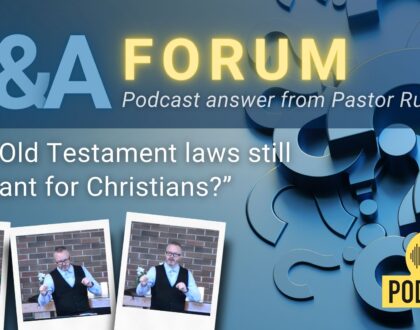A dummies guide to the bazillion translations of the Bible
by Westminster
By Pastor Matthew Ruttan
If you pull up an online bookseller or walk into a bookstore looking for a Bible, you might get confused. Quickly.
It seems like there are a bazillion translations and versions. As a result, I’m often asked what the difference is, and what I would recommend.
Let me give some background, and then I’ll tell you.
First, our modern day English Bibles are translations of ancient manuscripts. Generally speaking, most of the early Old Testament manuscripts are in Hebrew (with some parts in Aramaic), and most of the early New Testament manuscripts are in Greek. Teams of language scholars get together to translate them into English.
Second, the reason they do this is because of a belief that these manuscripts are eternally important. Most of the credible theories about the “inspiration” of the Bible say that the original authors and editors of those manuscripts were inspired by God when they did their work. In other words, God somehow directed their writing so that others would have access to that same wisdom through the ages.
Therefore, translators do their best to capture—in modern English—what those original authors and editors wrote. Today, we want to keep learning from that eternal wisdom. As I’ve often said to my congregation and readers.
Third, there are four main kinds of translations.
Formal Equivalence
The first is called “formal equivalence.” This kind of translation tries to be “word for word” in its translation of the original text. The historic King James Version (KJV) and the more recent English Standard Version (ESV) are like this.
This seems very noble, and often is. A benefit is that, as a reader, you get a sense that you are tracking along with the words of the text with a high amount of precision.
A detriment is that ancient languages do not always work the same as modern languages do. As a result, the translation can sometimes seem a bit wooden, and the original intent of a passage may get a bit lost because of a commitment to the word-for-word philosophy.
Dynamic Equivalence
The second kind of translation is “dynamic equivalence.” Where the previous kind of translation was word-for-word, this is a thought-for-thought approach. Examples would be the Good News Bible (Today’s English Version) or the New Living Translation (NLT).
A benefit is that, as a reader, the “flow” of the text is a bit smoother. It’s also helpful to keep in mind that translations like the NLT seem to have a particular concern with being understandable to those who are unfamiliar with technical, theological language.
For example, the ESV translation (which takes the word-for-word approach), translates Ephesians 2:8-9 like this:
For by grace you have been saved through faith. And this is not your own doing; it is the gift of God, not a result of works, so that no one may boast.
But the NLT translation (which takes a thought-for-thought approach, and which seems to have a sensitivity to a reader unfamiliar with technical language or concepts), translates the same passage like this:
God saved you by his grace when you believed. And you can’t take credit for this; it is a gift from God. Salvation is not a reward for the good things we have done, so none of us can boast about it.
Mixed Translation
The third kind of translation is a “mixed translation.” This essentially combines these first two approaches to translation. When a word-for-word approach can be used effectively, it is used; and when a thought-for-thought approach seems more appropriate, the translators switch to that.
Examples of this third kind of translation are the New International Version (NIV) and the Christian Standard Bible (CSB).
Paraphrase
The last kind of translation is a “paraphrase.” This approach takes, in my view, wider latitude with the text to communicate the idea behind it in contemporary language, even employing slang in certain situations.
One example might be Eugene Peterson’s “The Message.” Some might classify this as a paraphrase, but it might be better described as a “rendering.”
A benefit of this approach is that it brings a certain newness to ancient texts. Because of that, it can be useful for devotional reading, especially for those who need a kick-start. But I wouldn’t suggest it for serious Bible study or memorization. A detriment to this approach is that accuracy is sometimes lost, difficult textual issues can be glossed over, or the one doing the rendering can insert his or her own interpretation into the text itself.
For example, in Matthew 5:11-12 in the ESV (word-for-word) version, Jesus says:
Blessed are you when others revile you and persecute you and utter all kinds of evil against you falsely on my account. Rejoice and be glad, for your reward is great in heaven, for so they persecuted the prophets who were before you.
That same passage in The Message rendering says:
Not only that—count yourselves blessed every time people put you down or throw you out or speak lies about you to discredit me. What it means is that the truth is too close for comfort and they are uncomfortable. You can be glad when that happens—give a cheer, even!—for though they don’t like it, I do! And all heaven applauds. And know that you are in good company. My prophets and witnesses have always gotten into this kind of trouble.
As you can see, significant latitude is taken. I was in a small group last year where we were reading through a psalm. A person on my left had The Message, and a person on my right had the NIV, and they didn’t think they were reading the same passage!
Related to the issue of “paraphrasing” or “rendering” the biblical text, it should be noted that there are a number of modern translations by a single person instead of a team. Examples are works by N.T. Wright, David Bentley Hart, and Robert Alter. Individuals can have wonderful insights and consistency; at the same time, a translation team can lean on each other for wisdom and provide a safeguard against problems or personal hobby-horses.
My Own Preference
I use a variety of translations. In my devotional reading I basically switch it up. In my experience, all of the major Bible translations say essentially the same thing, but with a different approach and nuance. So by using many different translations, I benefit from different perspectives. Currently I’m reading through the CSB.
A side note: I said that the major Bible translations say essentially the same thing. You need to keep in mind that there are some translations, such as the New World Translation (used and distributed by the Jehovah’s Witnesses), which clearly mis-translate certain passages. Why? Some have suggested that this is to further a certain agenda. This teaches us that it is important to research your translation before buying it.
In preparation for preaching, I consult and study the original languages, and also a variety of translations week by week—the ESV, NIV, CSB, NRSV, NLT, KJV, GNV, and NJB. In the pulpit I tend to use the New International Version (NIV) (but not exclusively) since, as the most popular English-world translation right now, it is the one that most people have.
My Advice
If you struggle with the translations you’ve used up to this point, or if you are new to reading the Bible, I suggest the New Living Translation (NLT).
As you continue to grow, the New International Version (NIV), English Standard Version (ESV), or Christian Standard Bible (CSB) can also be very helpful.
I would advise that you invest in a “Study Bible” version of one of these translations. This means that your Bible will help you study by including:
- comprehensive footnotes which tell you more about the selection of specific words and cross-references to other similar passages
- study notes which explain difficult passages or concepts and which provide further clarifying information
- articles, maps and diagrams to help you broaden your understanding of ancient cultures, themes and textual meanings.
Recommendations
- The NIV Zondervan Study Bible, General Editor, D.A. Carson
- The Crossway ESV Study Bible
- The NLT Illustrated Study Bible by Tyndale House Publishers
An intelligent monk named Thomas Merton said that the Bible can be challenging, but it “is meant to challenge our intelligence, not insult it.” That’s why we should engage our minds in the use and study of the Bible. Find a good translation, and begin (or continue) your journey. The reward is beyond measure.
I hope this has been helpful. If you have any questions, please let me know!
- Sign up for my free daily 1-minute email devotional called ‘Up!’ here!
Recommended Posts

Four Signs of Spiritual Maturity
April 25, 2024
![Firm Faith in the Resurrection [Series Summary]](https://westminsterpc.ca/wp-content/uploads/2024/04/Apr.21-Sunday-Slides-Presentation2-420x330.jpg)
Firm Faith in the Resurrection [Series Summary]
April 18, 2024
